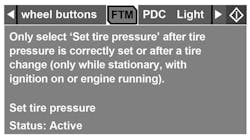Get serious about BMW 6-Series
SUBJECT VEHICLE: 2004-06 BMW 6-Series.
SENSOR IN TIRE? Yes.
RESET PROCEDURE? Yes. Directions follow.
SPECIAL TOOLS NEEDED? No.
The tire pressure monitoring system (TPMS) in 2004-06 BMW 6-Series vehicles keeps track of pressure levels in all four tires. If a significant drop in pressure is detected, the system will turn on a red tire pressure warning message on the control center, and also sound a warning signal. If there is a problem with the system itself, the warning light will be yellow.
When the low tire pressure warning light and message appears, immediately check air pressure of all the tires and adjust to the specified pressure. If the warning light still comes on after adjusting the tire pressure, repair the damaged tire.
NOTE: If a tire’s pressure has been adjusted, the TPMS must be re-initialized.
To remove an old sensor, follow these steps.
1. Raise the vehicle on a suitable support. Remove the tire/wheel assembly from the vehicle.
2. Demount the tire from the wheel following the tire changer manufacturer’s instructions. Pay special attention to the following to avoid damaging the tire pressure sensor:
a. To prevent the pressing-off horn from damaging the sensor, do not rest the pressing-off horn on both rim sides in the area of the valve.
b. The valve should be about 15 cm to the right of the assembly head to prevent the tire iron from damaging the sensor.
c. The tire bead must not press onto the sensor.
Don’t damage the sensor
To install a new sensor, follow these steps.
1. Mount the tire to the wheel following the tire changer manufacturer’s instructions while paying special attention to the following to avoid damaging the tire pressure sensor:
a. When the sensor is installed, the rim must not be cleaned with high-pressure cleaning equipment.
b. Visually inspect the sensor for the external damage and check for a tight fit. DO NOT retighten the screw and union nut. If one of the valve parts is loose, replace the entire valve.
c. Keep the sensor free of tire mounting paste.
d. Fit the lower tire bead so that no pressure forces are exerted on the sensor.
e. Fit the upper tire bead so that no pressure forces are exerted on the sensor.
2. Install the tire/wheel assembly on the vehicle.
Now you are ready to re-initialize the TPMS. NOTE: If a wheel or tire has been replaced, or repairs have been made to the air spring suspension, the TPMS must be re-initialized.
1. Set the tire pressure of all wheels to specification.
2. Press “Menu” button.
3. Open the “I” menu of the control center.
4. Select “Vehicle Settings” and press the controller.
5. Select “FTM” and press the controller. See Figure 1.
6. Start the engine; do not start driving.
7. Select “Set Tire Pressure” and press the controller. See Figure 2.
8. Select “Yes” and press the controller.
9. Drive the vehicle. The message “Initializing” will be displayed. Initialization is automatically completed during the drive. When initialization is complete, “Status: Active” message will be displayed.
NOTE: The initialization finishes during driving, which can be interrupted at any time. When driving resumes, the initialization is continued automatically.
Information for this column comes from Mitchell 1’s “Tire Pressure Monitoring Systems Guide” for domestic and import vehicles through 2010. Headquartered in Poway, Calif., Mitchell 1 has provided quality repair information solutions to the automotive industry for more than 80 years. For more information, visit www.mitchell1.com.
